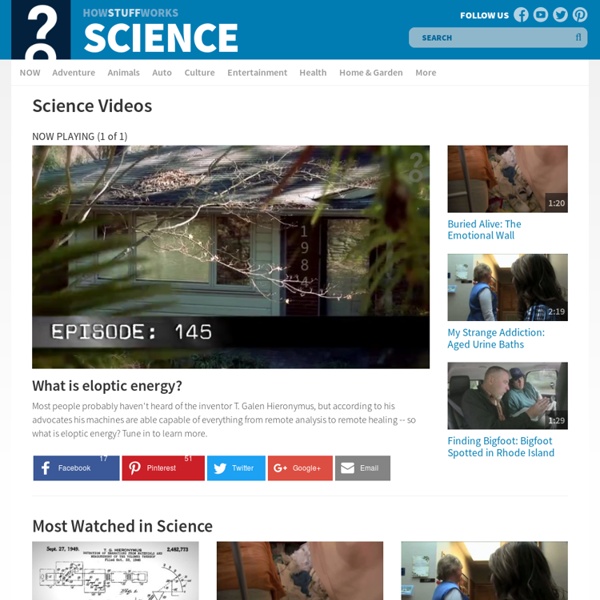



At-Bristol Invisibility cloaks might sound like science fiction, but Ross of the Live Science Team shows you how a trick of light can make things disappear in this great experiment to try at home! This video was presented by: Ross Exton, Live Science Video ProducerProduced by: Ross Exton & Seamus Foley, Big Screen Producer The science of sweets: Eyeball dissection: Twitter: what the Live Science Team gets up to on a daily basis: Facebook: At-Bristol is an educational charity and one of the UK's leading science and discovery centres, with the aim of making science accessible to all. Our YouTube channel gives you an exciting behind-the-scenes look at the people, places, exhibits, and experiments that bring science to life! Find out more about At-Bristol: Music: Provided courtesy of YouTube Audiolibrary Show less
Exploration Tools 3-D Angles Visualizing three-dimensional structures is a major hurdle for chemistry students. Compounding the difficulty, chemists use three different concepts to imply geometry, although there is no obvious geometric information in two of them. The bond angle (a geometric construct) can be known from noting either the hybridization of the central atom (a quantum mechanical construct) or the coordination number (the number of other atoms bonded to the central atom). 3-D Angles uses pattern recognition principles introduced through rapid repeated exposure to three concepts to teach students to intuitively associate the three terms together in order to be able to correctly recognize the molecular structure from limited information. Current version 3.0 (October 19, 2010) System requirements Windows XP, Windows Vista, or Windows 7 Setup program 3-D_Angles_Setup.exe (2.94 MB) Programmer Stephen Michael Schimpf Crystalline Solids Crystalline Solids attempts to meet that need. GraphLab Worksheets K vs.
Educational Videos and Games for Kids about Science, Math, Social Studies and English Lead Prices News Thursday, August 4, 2011 Gold prices were lower Thursday at the close of trade, droppoing $7.30 from Wednesday’s close to $1,659 per troy ounce, but not before it set a new intraday high at $1,684.90 per troy ounce and traded as low as $1,642.20 per troy ounce during the session. The decline came as equities markets dropped, making some [...] Wednesday, August 3, 2011 Gold prices remained in record territory Wednesday as investors looked for safe places to put their cash on declines in equities markets around the world. Tuesday, August 2, 2011 Gold prices hit new highs Tuesday in New York trade after the US Commerce Department reported that consumer spending in the United States was down by 0.2 percent in June against an expected gain of 0.1 percent, the first decline in nearly two years, while personal income was up by just 0.1 percent, the smallest [...] Wednesday, July 20, 2011 Tuesday, July 19, 2011 Wednesday, July 6, 2011 Friday, July 1, 2011 Thursday, June 30, 2011 Wednesday, June 22, 2011
Kemikalendern Kalendern består av tolv inspirationsfilmer med tolv tolv tillhörande laborationsfilmer. Samtliga knyter an till LGR 11. Filmerna är cirka 5 minuter långa och visar olika exempel på kemi i vår omgivning, sett genom en nyfiken och utforskande persons ögon. I kemikalendern ingår även ett undervisningsmaterial med fakta och laborationsinstruktioner per tema. Undervisningsmaterialet är utformat med utgångspunkt för lärare och deras elever på mellanstadiet och uppåt. Klicka här för att prenumerera på kalendern som kommer ut en gång i månaden under 2015. Vill du hellre ha hela kalendern samlad på en DVD kan du beställa den gratis här. Kemikalendern är framtagen av Chalmers, Göteborgs universitet, Universeum och Molecular Frontiers för att ge roliga och användbara upplevelser till lärare och elever i olika åldrar. Kontaktpersoner: Kerstin Jönsson. Januari: Konst och kultur Februari: Mode I alla tider har människan använt sig av kemi för att klä upp sig och att göra sig fin. Mars: Energi och klimat
JeLSIM Simulating Experiments Online This project grew out of a belief in the benefits of simulation, and a realisation that there is still some way to go if they are to achieve their full potential in online learning. We view the project as a chance to take a fresh look at the criticisms of simulation raised in education literature and as an opportunity to address them. A particular area of interest, is integration of simulations and assessment and the provision of "authentic" assessment where assessment is carried out in the environment in which learning takes place. The possibility of combining a proposal to UCLES to look at the above issues with one to suit the specific needs of the SQA within the PASS-IT project led to a focus on use of simulations in building up skills in practical activities and experimentation. PASS-IT Networking Day These materials were presented at the PASS-IT Networking Day, held at the Scottish Executive, Victoria Quay, Edinburgh on 5th March 2003.
Build an Atom - Atomic Structure, Atoms, Atomic Nuclei Topics Atoms Atomic Structure Isotope Symbols Atomic Nuclei Description Build an atom out of protons, neutrons, and electrons, and see how the element, charge, and mass change. Then play a game to test your ideas! Sample Learning Goals Use the number of protons, neutrons, and electrons to draw a model of the atom, identify the element, and determine the mass and charge.Predict how addition or subtraction of a proton, neutron, or electron will change the element, the charge, and the mass.Use the element name, mass, and charge to determine the number of protons, neutrons, and electrons.Define proton, neutron, electron, atom, and ion.Generate an isotopic symbol for an atom, given the number of protons, neutrons, and electrons.